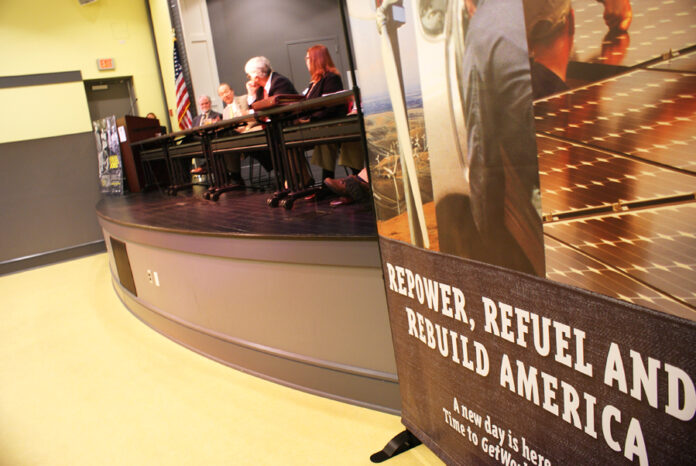
“New Ideas for Tomorrow – Green Jobs and Energy in a Changing World,” was the title of a panel discussion held recently at the Claude Moore Education Complex. The Moore Complex, a renovated theatre, has been hailed as one of the greenest buildings in the state.
Green building techniques, espoused by people like panelist Stan Breakell (Breakell Construction) and alternative energy sources were on the topic list, as well as one advocate for clean coal.
“We have three energy problems,” said introductory speaker John Randolph, from Virginia Tech, “oil, carbon and global demand.”
Randolph said initiatives like the Clean and Green Business Coalition in Roanoke are “national calls for action. The opportunities are boundless.”
Breakell said taking the first step to address global warming and greenhouse gas emissions, whether for a business or a municipality, is “so hard, [but] once you’ve taken it, it becomes easier.”
For companies and homeowners, that first step can be as simple as replacing incandescent bulbs with the fluorescent ones Breakell likes to hand out.
“Its up to you to demand the level of efficiency you would need in your building.” Breakell touted Virginia Western Community College as the perfect place to train workers for green jobs, which he said were not “something out there,” but a reality now.
Lee Wilhelm of McNeil Roofing touted green roofs, where plants are used in some cases to help cool off the top of a building – keeping energy costs down in the process.
“For many years the roof was probably the most ignored part of the building,” said Wilhelm, adding that a green roof can also be something as simple as using materials and paint that doesn’t absorb too much sun.
Non-green roof temperatures can soar to as high as 160 degrees in these parts, said Wilhelm, who currently has a dozen or so green roof projects in the works. Wilhelm noted that the Claude Moore building (on Henry Street) also has a green roof installed. Planted roofs also help keep water out of sewers, aiding flood control – and they create jobs. “It takes people to grow the plants,” noted Wilhelm.
Blacksburg Mayor Ron Rordam talked about a LEED-certified renovated building his town is currently working on.
“I’m a big believer in the power of localities,” said Rordam, who assembled a task force on climate change in Blacksburg. Local governments should “lead by example,” he added.
Balzer & Associates architect Monica Rokiki helped form a citizen’s environmental group in Houston. She said greener buildings start with getting everyone on the same page.
“Then we get better performing buildings,” Rokiki said. She envisions mortgages with lower rates for buildings that meet a green underwriting standard. “We need to get more educated.” Rokiki will help conduct a green practices seminar August 1 at the Taubman Museum of Art.
“We want to be on the cutting edge of the new jobs that are created.” Steelworkers can build wind turbines for starters, said Bare.
State Senator John Edwards (D-Roanoke) capped off the conference, organized in part by a group called the Environmental Defense League.
“This is the greatest building in Virginia [energy-wise],” said Edwards, noting that rainwater collected on the Claude Moore roof is reused in bathrooms, with solar panels employed to preheat water as well. “We decided to make this a model,” said Edwards, who also made a pitch for public rail transportation as a way to take cars off the road and reduce carbon emissions.


